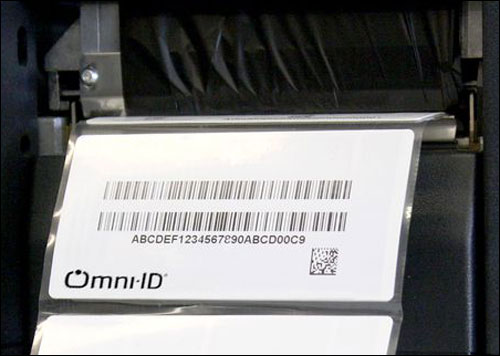Ultrahigh-frequency (UHF) RFID tag manufacturer Omni ID has added two new passive UHF tags to its range of IQ RFID tags—part of its UltraThin line of tags aimed at making the RFID-tracking of metal and liquid items easier and less expensive. The new IQ 400 and IQ 600 tags are designed to provide on-metal functionality in the form of a hard tag, but can be printed on a thermal bar-code printer and then be affixed to an item via the tags’ built-in adhesive. In that way, the tags are intended to save users the cost of applying hard tags to assets or other items, since they can be printed on a roll that could then be applied more easily. However, the tags are also intended to offer greater functionality in the presence of metal and liquids than a traditional dipole label.
The tags result from continued engineering that follows the March 2012 release of two thin tags intended for use around metal or liquids (see Omni-ID Launches UltraThin Metal-Mount Tags), explains Tony Kington, the company’s managing director in Europe, as well the chairman of the board of the company’s China division. The UltraThin product line began its development as early as 2006, he says, when “it was clear there were a number of applications in which there was a real need for a low-profile product,” that would operate well on metal. The first resulting products—the Flex LP and Flex Al tags—provided on-metal functionality. However, those versions measure 1.2 millimeters (0.05 inch) and 1.45 millimeters (0.06 inch) in thickness, respectively, while the IQ 400 and IQ 600 models are only 0.8 millimeter (0.03 inch) thick. In addition, the Flex LP and Flex Al tags are not sold on a roll; therefore, users were unable to print and encode the Flex tags onsite by means of a thermal printer.
Since the Flex tags’ release this spring, there have between 30 and 40 users globally that have been purchasing the tags, typically in units of approximately 100,000. The labels are being applied to medical equipment and blood bags in the health-care environment; on products stored on metal-frame storage racks in the logistics arena; and on consumer electronics, weapons and tools—all of which contain a large quantity of metal that would negatively impact transmission via a standard dipole UHF tag.
However, Kington says, with the tags in use, engineering work continued at Omni-ID to develop a tag with mass-production and simple on-site deployment in mind. “We wanted a tag that could be processed through a thermal printer easily,” he states. Affixing a tag onto an asset from a roll requires minimal labor, he adds, while a tag on a sheet that would need to be printed and encoded in advance requires additional labor, and ultimately greater cost for a user.
Omni-ID’s development work took place within its own laboratories in Farnham, in the United Kingdom, as well as in the lab of its manufacturing partner, Yeon Technologies, headquartered in Taiwan. This was accomplished together with design-validation support provided by AdhTech, in Sweden, and several major printer manufacturers.
Both the IQ 400 and IQ 600 tags can now be purchased as finished labels, or as inlays that can then be converted into labels. The finished labels are composed of a multilayer synthetic with an acrylic adhesive and a polyethylene terephthalate (PET) face laminate. The IQ 600 tag measures 101.0 millimeters by 50.0 millimeters (4 inches by 2 inches) and weighs 5 grams (0.12 ounce), while the IQ 400 model measures 103.0 millimeters by 28.0 millimeters (4 inches by 1 inch) and weighs 2.8 grams (0.01 ounce). Both tags feature an Impinj Monza 4QT chip with 512 bits of user memory. When used with a fixed reader, the IQ 600 tag has a read range of up to 19.7 feet when mounted on metal, while the IQ 400 has an on-metal read range of up to 13 feet.The tags were tested for thermal shock, high temperatures and adhesion to metal, as well as the ability to sustain a range of solvents. They proved to perform well around cleaning agents, Kington says, and at temperatures of up to 85 degree Celsius (185 degrees Fahrenheit), meaning they can sustain steam-cleaning and other typical cleaning processes. The labels come in rolls of 200, and can be printed on any thermal RFID-enabled printer.
The price is higher than that of a traditional dipole tag, but less than that of a hard tag, Kington says, who declines to provide specific pricing. The on-metal functionality would otherwise require a hard tag, he notes, adding, “We positioned the unit price to be aggressive compared to that of the hard tag.” By using the tag, Kingston says, “there will be a cost reduction for those looking for on-metal tags” in comparison with the other on-metal hard tags on the market.
Kington says he’s most enthusiastic about the quality of the tags’ read reliability on metal and liquids—something, he reports, that has proven to be very high in Omni-ID’s testing. Several companies are currently beta-testing the tags, including logistics firms using the IQ 600 model in warehouse settings, as well as businesses utilizing the IQ 400 version to track IT assets and weapons. The tags were commercially launched last month in Asia, and this week in North America and Europe.
Since releasing the IQ 400 and IQ 600 tags, Kington says, Omni-ID has fielded hundreds of requests regarding the technology from companies or agencies interested in trialing them. Samples are available immediately, he reports, while large orders will require a lead of two to four weeks.
In April of this year, Omni-ID released two other tags in the UltraThin series: the IQ 400P and IQ 800P dipole tags, both of which can be attached to plastic containers. The IQ 400P and IQ 800P labels, made with an Alien Technology Higgs 3 chip offering 512 bits of user memory, can be printed on a thermal printer, and are designed to be highly durable. They are also IP68-rated, meaning they can withstand complete immersion in water.
In February 2012, Xerafy introduced its own thin on-metal EPC UHF tag, known as the Metal Skin inlay, which measures 3.54 inches by 1.18 inches by 0.026 inch (90 millimeters by 30 millimeters by 0.66 millimeters). Through standard label-converting equipment and processes, the Metal Skin inlay can be embedded in RFID labels capable of being printed with logos and bar-coding by means of standard RFID printers (see RFID News Roundup: Xerafy Introduces Flexible UHF Inlay for Tracking Metal Assets).



